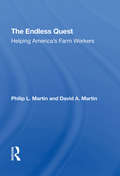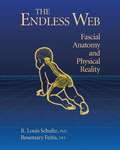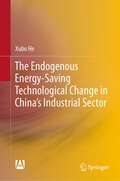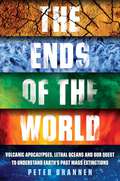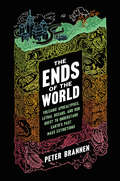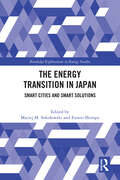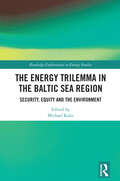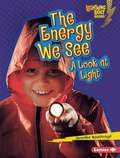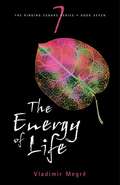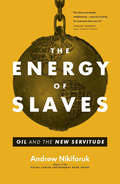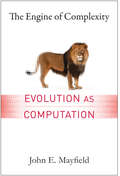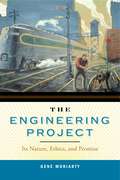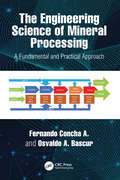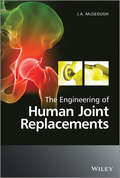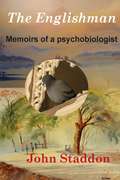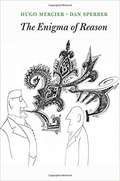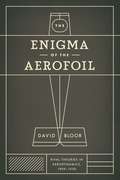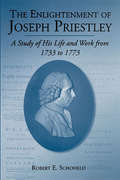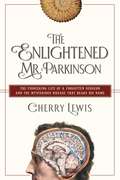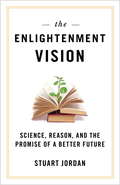- Table View
- List View
The Endless Crisis: America in the Seventies
by Francois DucheneThe Endless crisis: America in the seventies; a confrontation of the world's leading social scientists on the problems, impact, and global role of the United States in the next decade.
The Endless Quest: Helping America's Farm Workers
by Philip L Martin David A MartinA work which traces the development of US Government programmes designed to help migrant farm workers, showing how the programmes operate today and explaining why they are failing to remedy the problems they were designed to solve.
The Endless Web: Fascial Anatomy and Physical Reality
by R. Louis Schultz Rosemary Feitis Ronald Thompson Diana SallesThe result of more than two decades of research and practice, The Endless Web presents in clear, readable language a comprehensive guide to understanding and working effectively with the myofascial system, the 'packing material' of the body. Myofascia is a flexible network of tissue that surrounds, cushions, and supports muscles, bones, and organs. It also acts as a riverbed containing the flow of interstitial fluid, and is a critical influence on the immune and hormonal systems. In daily life, this connective tissue is an underlying determinant of movement quality, modd, alertness, and general well-being. The Endless Web is a fully illustrated guide to understanding how myofascia works, it supportive role within the body's anatomy, and how gentle manipulation of the myofascial tissue is central to lasting therapeutic intervention and how it can be integrated into any bodywork practice.
The Endogenous Energy-Saving Technological Change in China's Industrial Sector
by Xubo HeAs improving energy efficiency and increasing energy R&D investment may be the main means for China's industrial sector to achieve sustainable growth, this book attempts to unify energy use efficiency and energy R&D inputs into a standardized economic analysis framework. By distinguishing between energy R&D inputs and non-energy R&D inputs, this book draws on the research paradigm of neoclassical economics to clarify the basic concepts and endogenous mechanisms of energy-saving technological progress as a logical starting point. Under the framework of the existing endogenous growth theory analysis, the heterogeneous R&D inputs are divided into two different mechanisms that affect energy use efficiency, namely factor substitution effect and energy-efficient input increase effect, and a heterogeneous R&D input is constructed. This book constructed an analytical framework for endogenous energy-saving technological progress in the industrial sector based on heterogeneous R&D inputs; it established a mathematical model for the endogenous energy-saving technological advancement of the industrial sector based on heterogeneous R&D inputs; it estimated the energy-saving technological progress rate of 37 Chinese industrial sub-sectors from 1980 to 2010; fourth, it has empirically examined the relationship between the heterogeneous R&D investment in China's industrial sector and its energy-saving technological advancement rate.
The Ends of the World: Volcanic Apocalypses, Lethal Oceans and Our Quest to Understand Earth’s Past Mass Extinctions
by Peter BrannenApocalypse, now? Death by fire, ice, poison gas, suffocation, asteroid. At five moments through history life on Earth was dragged to the very edge of extinction. Now, armed with revolutionary technology, scientists are uncovering clues about what caused these catastrophes. Deep-diving into past worlds of dragonflies the size of seagulls and fishes with guillotines for mouths, they explore how – against all the odds – life survived and what these ominous chapters can tell us about our future.
The Ends of the World: Volcanic Apocalypses, Lethal Oceans, and Our Quest to Understand Earth's Past Mass Extinctions
by Peter BrannenAs new groundbreaking research suggests that climate change played a major role in the most extreme catastrophes in the planet's history, award-winning science journalist Peter Brannen takes us on a wild ride through the planet's five mass extinctions and, in the process, offers us a glimpse of our increasingly dangerous future Our world has ended five times: it has been broiled, frozen, poison-gassed, smothered, and pelted by asteroids. In The Ends of the World, Peter Brannen dives into deep time, exploring Earth’s past dead ends, and in the process, offers us a glimpse of our possible future.Many scientists now believe that the climate shifts of the twenty-first century have analogs in these five extinctions. Using the visible clues these devastations have left behind in the fossil record, The Ends of the World takes us inside “scenes of the crime,” from South Africa to the New York Palisades, to tell the story of each extinction. Brannen examines the fossil record—which is rife with creatures like dragonflies the size of sea gulls and guillotine-mouthed fish—and introduces us to the researchers on the front lines who, using the forensic tools of modern science, are piecing together what really happened at the crime scenes of the Earth’s biggest whodunits.Part road trip, part history, and part cautionary tale, The Ends of the World takes us on a tour of the ways that our planet has clawed itself back from the grave, and casts our future in a completely new light.
The Energy Paradox: What to Do When Your Get-Up-and-Go Has Got Up and Gone (The Plant Paradox #6)
by Dr. Steven R Gundry, MDThe author of the bestselling Plant Paradox series takes a fresh look at one of the top health issues plaguing Americans—fatigue—and offers a revolutionary plan for boosting energy and revitalizing mental and physical stamina.In his bestselling books, The Plant Paradox and The Longevity Paradox, Dr. Steven R. Gundry offered game-changing perspectives on our wellbeing. In The Energy Paradox, Dr. Gundry expands upon his previous discussions of gut, microbiome, and mitochondrial health, linking immune malfunction to the mental and physical symptoms of fatigue—including exhaustion, brain fog, depression, anxiety, and low metabolism.As Dr. Gundry explains, feeling tired, moody, and zapped of energy is not normal, no matter your workload or age. Fatigue is an SOS flare from the body, one that is intended to alert us that something is wrong. In his clinical work, Dr. Gundry has found that his patients who complain of feeling sick and tired all the time almost always have something in common: the inflammation markers of a leaky gut.In The Energy Paradox, Dr. Gundry will offer readers the information and tools necessary to quiet the autoimmune battle raging within—a battle that depletes precious energy reserves, leaving you drained and prone to mood disorders and weight gain. With new guidelines on how to increase mitochondrial energy production and nourish the microbiome; 30 new Plant Paradox-approved recipes; and lists of energy-boosting foods to consume and energy-depleting foods to avoid, The Energy Paradox will help readers take back their lives, giving them the energy they need to feel, look, and be their best.
The Energy Transition in Japan: Smart Cities and Smart Solutions (Routledge Explorations in Energy Studies)
by Maciej M. Sokołowski Fumio ShimpoThis book offers a distinctive and comprehensive view of the energy transition of Japan, with a particular focus on the rise of smart cities.Drawing on real examples from Japan’s journey towards carbon neutrality, this volume examines a variety of topics ranging from laws and policies to technological and managerial solutions, discussing them in the context of Japan’s energy transition. Among the issues covered by the book are climate action planning, sustainable waste management, energy poverty, decarbonisation, e-methane, transport policies, and smart grids. The book also explores the regulatory tools that either support or hinder the development of smart cities in Japan, and how Japan can leverage its national solutions globally. In this way, this book serves as a guide for global climate action and energy transitions around the world.Focusing on both stories of success and lessons learned, this book will be a valuable resource for students and scholars of energy transitions, climate action, smart cities, as well as Asian and Japanese studies more broadly.
The Energy Trilemma in the Baltic Sea Region: Security, Equity and the Environment (Routledge Explorations in Energy Studies)
by Michael KalisThe Energy Trilemma in the Baltic Sea Region provides insight into the energy trilemma in the Baltic Sea Region.Energy Trilemma in the Baltic Sea Region has undergone significant transformation in the last number of years. Energy actors in the region are struggling to reconcile new questions of energy security following the COVID-19 pandemic and the invasion of Ukraine with net-zero objectives and a cost-of-living crisis. Balancing these concerns is essential to resolving the “energy trilemma”: the dilemma that emerges for policy-makers and regulators seeking to balance energy security, equity, and environmental concerns in pursuit of a wholly sustainable energy system. This volume draws together a range of perspectives from scholars of the Baltic Sea Region seeking to understand the manifestations and impact of these systemic regional changes. In considering previously underexamined studies on the energy trilemma and in providing new perspectives by framing the trilemma in times of crisis, this book provides new conceptual and empirical insight into a rapidly changing energy region at the heart of both European energy policy and the current energy crisis.This volume will be of great interest to students and scholars of energy politics, energy law and policy, energy transitions, and Baltic studies more broadly.
The Energy We See: A Look at Light (Lightning Bolt Books #Exploring Physical Science)
by Jennifer BoothroydLight shines through your kitchen window. A campfire brightens the dark woods. You see light all around you. But where does most light come from? And how does it travel? Read this book to find out! Learn all about matter.
The Energy of Life (The Ringing Cedars Series #7)
by Vladimir Megré John Woodsworth Leonid SharashkinMan's life! On what or on whom does it depend? Why do some become emperors or regimental commanders, while others are obliged to fend for scraps at garbage dumps? One opinion holds that each person's fate is pre-determined from birth. That would make Man nothing more than an insignificant cog in some mechanised system, and not the highly organised creation of God.
The Energy of Slaves: Oil and the New Servitude
by Andrew Nikiforuk&“A robustly researched and smoothly written overview of the many challenges confronting our devotion to fossil fuels&” from the author of Tar Sands (Quill & Quire). Ancient civilizations relied on shackled human muscle. It took the energy of slaves to plant crops, clothe emperors, and build cities. Nineteenth-century slaveholders viewed critics as hostilely as oil companies and governments now regard environmentalists. Yet the abolition movement had an invisible ally: coal and oil. As the world&’s most versatile workers, fossil fuels replenished slavery&’s ranks with combustion engines and other labor-saving tools. Since then, cheap oil has transformed politics, economics, science, agriculture, and even our concept of happiness. Many North Americans today live as extravagantly as Caribbean plantation owners. We feel entitled to surplus energy and rationalize inequality, even barbarity, to get it. But endless growth is an illusion. In this provocative book, Andrew Nikiforuk, winner of the Rachel Carson Environment Book Award, argues that what we need is a radical emancipation movement that ends our master-and-slave approach to energy. We must learn to use energy on a moral, just, and truly human scale. Published in Partnership with the David Suzuki Institute &“In his cautionary tale about the evils of oil . . . Nikiforuk makes his case for impending doom if we don&’t mend our energy-spending ways.&” —The Star &“In this cogently argued book, Andrew Nikiforuk deploys a powerful metaphor. Oil dependency, he writes, is a modern form of slavery—and it&’s time for a global abolition movement.&” —Taras Grescoe, author of Shanghai Grand &“A startling critique that should rouse us from our pipe dream of endless plenty.&” —Ronald Wright, author of On Fiji Islands
The Engine of Complexity
by John MayfieldThe concepts of evolution and complexity theory have become part of the intellectual ether permeating the life sciences, the social and behavioral sciences, and more recently, management science and economics. In this new title, John Mayfield elegantly synthesizes core concepts from across disciplines to offer a new approach to understanding how evolution works and how complex organisms, structures, organizations, and social orders can and do arise based on information theory and computational science.This is a big picture book intended for the intellectually adventuresome. While not deeply technical or mathematical in style, the text challenges readers and rewards them with a nuanced understanding of evolution and complexity that offers consistent, durable, and coherent explanations for major aspects of our life experiences. Numerous examples throughout the book illustrate evolution and complexity formation in action and highlight the core function of computation lying at the heart of the book.
The Engine of Complexity: Evolution as Computation
by John E. MayfieldThe concepts of evolution and complexity theory have become part of the intellectual ether permeating the life sciences, the social and behavioral sciences, and more recently, management science and economics. In this new title, John Mayfield elegantly synthesizes core concepts from across disciplines to offer a new approach to understanding how evolution works and how complex organisms, structures, organizations, and social orders can and do arise based on information theory and computational science. This is a big picture book intended for the intellectually adventuresome. While not deeply technical or mathematical in style, the text challenges readers and rewards them with a nuanced understanding of evolution and complexity that offers consistent, durable, and coherent explanations for major aspects of our life experiences. Numerous examples throughout the book illustrate evolution and complexity formation in action and highlight the core function of computation lying at the heart of the book.
The Engine of Complexity: Evolution as Computation
by John MayfieldThe concepts of evolution and complexity theory have become part of the intellectual ether permeating the life sciences, the social and behavioral sciences, and more recently, management science and economics. In this new title, John Mayfield elegantly synthesizes core concepts from across disciplines to offer a new approach to understanding how evolution works and how complex organisms, structures, organizations, and social orders can and do arise based on information theory and computational science.This is a big picture book intended for the intellectually adventuresome. While not deeply technical or mathematical in style, the text challenges readers and rewards them with a nuanced understanding of evolution and complexity that offers consistent, durable, and coherent explanations for major aspects of our life experiences. Numerous examples throughout the book illustrate evolution and complexity formation in action and highlight the core function of computation lying at the heart of the book.
The Engine of Complexity: Evolution as Computation
by John MayfieldThe concepts of evolution and complexity theory have become part of the intellectual ether permeating the life sciences, the social and behavioral sciences, and, more recently, management science and economics. In this book, John E. Mayfield elegantly synthesizes core concepts from multiple disciplines to offer a new approach to understanding how evolution works and how complex organisms, structures, organizations, and social orders can and do arise based on information theory and computational science. Intended for the intellectually adventuresome, this book challenges and rewards readers with a nuanced understanding of evolution and complexity that offers consistent, durable, and coherent explanations for major aspects of our life experiences. Numerous examples throughout the book illustrate evolution and complexity formation in action and highlight the core function of computation lying at the work's heart.
The Engineering Project: Its Nature, Ethics, and Promise
by Gene MoriartyWe all live our daily lives surrounded by the products of technology that make what we do simpler, faster, and more efficient. These are benefits we often just take for granted. But at the same time, as these products disburden us of unwanted tasks that consumed much time and effort in earlier eras, many of them also leave us more disengaged from our natural and even human surroundings. It is the task of what Gene Moriarty calls focal engineering to create products that will achieve a balance between disburdenment and engagement: “How much disburdenment will be appropriate while still permitting an engagement that enriches one’s life, elevates the spirit, and calls forth a good life in a convivial society?”One of his examples of a focally engineered structure is the Golden Gate Bridge, which “draws people to it, enlivens and elevates the human spirit, and resonates with the world of its congenial setting. Humans, bridge, and world are in tune.” These values of engagement, enlivenment, and resonance are key to the normative approach Moriarty brings to the profession of engineering, which traditionally has focused mainly on technical measures of evaluation such as efficiency, productivity, objectivity, and precision. These measures, while important, look at the engineered product in a local and limited sense. But “from a broader perspective, what is locally benign may present serious moral problems,” undermining “social justice, environmental sustainability, and health and safety of affected parties.” It is this broader perspective that is championed by focal engineering, the subject of Part III of the book, which Moriarty contrasts with “modern” engineering in Part I and “pre-modern” engineering in Part II.
The Engineering Science of Mineral Processing: A Fundamental and Practical Approach
by Osvaldo A. Bascur Fernando Concha AThe Engineering Science of Mineral Processing: A Fundamental and Practical Approach emphasizes the fundamentals of mineral processing to provide readers with a deep understanding of the science and phenomena that occur during the processing of ores. It also offers guidance on contemporary process implementation through practical industry applications. It includes examples of dynamic simulations and practical execution of advanced software to guide operating plans to ensure optimal conditions that predict process constraints. Focuses on the science of mineral processing, including particulate systems, hydrodynamics, and physical chemistry Discusses modeling, rheology, comminution, classification, flotation, and solid-liquid separation Includes practical examples from real-world industrial applications Provides information on dynamic process simulations and the application of digital twins in mineral processing plants to improve management and efficiency Details the future of mineral processing in the digital era. Offering a balance between fundamentals and applications, this book will be of interest to researchers and industry professionals working to optimize mining, mineral and chemical processing plants. It will also be of value to advanced students taking mineral processing and chemical engineering courses.
The Engineering of Human Joint Replacements
by J. A. McgeoughSince the major pioneering of joint replacement surgery more than fifty years ago, much research and progress has been made in the field of arthroplasty with new insights into better materials, types of cement and bone-cell compatible coatings, and a better understanding of the causes of implant failure. With an increasingly ageing population the requirement for arthroplastic surgery is manifest; over 800,000 hips worldwide are replaced each year, and replacement surgery is performed for almost every joint of the body.The Engineering of Human Joint Replacements covers the design, engineering, production and manufacture of human joint replacements, as well as associated engineering concerns such as surface coatings, orthopedic bone cement, the causes and effects of wear and tear, and rapid prototyping for clinical evaluation. Materials evaluation and selection is discussed, as well as production processes and insertion methods. The author provides an overview of skeletal anatomy and the effects of pain and deterioration in order to put the engineering principles into a medical context. Examples of joint replacements for the most common regions of the body are included, and aspects of clinical studies of these cases are discussed.Key Features:* Provides an overview of the engineering materials and processes involved in the manufacture of human joint replacements* Sets the scene for engineers and clinicians embarking on research into joint replacements* Includes clinical and industrial examples and points the way to future developments* Provides information on medical device companies with an engineering guide to the requirements for joint replacementThe Engineering of Human Joint Replacements bridges the divide between engineering and orthopaedic surgery, offering an introductory text to young engineers entering the field, as well as a reference for medical staff who will benefit from an understanding of the materials and methods used in their design, engineering and manufacture.
The Englishman: Memoirs of a Psychobiologist
by John Staddon"Although I have been basically an academic for most of my life, the way I got there has taken some surprising turns. The first four chapters of this memoir describe what I can remember and discover about my early life: an unsuspected ancestry, fun in WW2 London, comical schooldays, and a spell in colonial Africa interrupting a wobbly college career at the end of which I left England for America. In the US I followed again a slightly erratic graduate-school trajectory that ended up in a Harvard basement."This is not just a witty transatlantic autobiography from a talented English working-class kid who made his name in the USA but also a learned and entertaining romp through the subject he has made his own. Growing up in a modest odd family out in wartime England, and with a natural resistance to regimentation, John Staddon was the precocious self-driven polymath who first studied chemical engineering but switched to psychology because there were only four or five classes a week. By way of his wide-ranging interests in biology, artificial intelligence, economics, philosophy and behavioural neuroscience, John Staddon introduces his important work on how animals learn. He discusses the still relatively new and exciting field of behavioural psychobiology, explains theoretical research on choice and interval timing and debates so-called superstition in the learned behaviour of pigeons, rats, fish - and people. Here is a most entertaining life story interwoven with expansive thoughts across the marvellously wide spectrum of behavioural psychology.
The Enigma of Reason
by Hugo MercierIf reason is so useful and reliable, why didn’t it evolve in other animals and why do humans produce so much thoroughly reasoned nonsense? Hugo Mercier and Dan Sperber argue that reason is not geared to solitary use. It evolved to help justify our beliefs to others, evaluate their arguments, and better exploit our uniquely rich social environment.
The Enigma of the Aerofoil
by David BloorWhy do aircraft fly? How do their wings support them? In the early years of aviation, there was an intense dispute between British and German experts over the question of why and how an aircraft wing provides lift. The British, under the leadership of the great Cambridge mathematical physicist Lord Rayleigh, produced highly elaborate investigations of the nature of discontinuous flow, while the Germans, following Ludwig Prandtl in Göttingen, relied on the tradition called "technical mechanics" to explain the flow of air around a wing. Much of the basis of modern aerodynamics emerged from this remarkable episode, yet it has never been subject to a detailed historical and sociological analysis. In The Enigma of the Aerofoil, David Bloor probes a neglected aspect of this important period in the history of aviation. Bloor draws upon papers by the participants--their restricted technical reports, meeting minutes, and personal correspondence, much of which has never before been published--and reveals the impact that the divergent mathematical traditions of Cambridge and Göttingen had on this great debate. Bloor also addresses why the British, even after discovering the failings of their own theory, remained resistant to the German circulation theory for more than a decade. The result is essential reading for anyone studying the history, philosophy, or sociology of science or technology--and for all those intrigued by flight.
The Enlightened Joseph Priestley: A Study of His Life and Work from 1733 to 1773
by Robert SchofieldJoseph Priestley (1733–1804) is one of the major figures of the English Enlightenment. A contemporary and friend of Benjamin Franklin and Thomas Jefferson, he exceeded even these polymaths in the breadth of his curiosity and learning. Yet no one has attempted an all-inclusive biography of Priestley, probably because he was simply too many persons for anyone easily to comprehend in a single study. Robert Schofield has devoted a lifetime of scholarship to this task. The result is a magisterial book, covering the life and works of Priestley during the critical first forty years of his life. <P><P>Although Priestley is best known as a chemist, this book is considerably more than a study in the history of science. As any good biographer must, Schofield has thoroughly studied the many activities in which Priestley was engaged. Among them are theology, electricity, chemistry, politics, English grammar, rhetoric, and educational philosophy. Schofield situates Priestley, the provincial dissenter, within the social, political, and intellectual contexts of his day and examines all the works Priestley wrote and published during this period. <P><P>Schofield singles out the first forty years of Priestley's life because these were the years of preparation and trial during which Priestley qualified for the achievements that were to make him famous. The discovery of oxygen, the defenses of Unitarianism, and the political liberalism that characterize the mature Priestley—all are foreshadowed in the young Priestley. A brief epilogue looks ahead to the next thirty years when Priestley was forced out of England and settled in Pennsylvania, the subject of Schofield's next book. But this volume stands alone as the definitive study of the making of Joseph Priestley.
The Enlightened Mr. Parkinson: The Pioneering Life Of A Forgotten Surgeon
by Cherry LewisA colorful and absorbing portrait of James Parkinson and the turbulent, intellectually vibrant world of Georgian London. Parkinson’s disease is one of the most common forms of dementia, with 60,000 new cases each year in the United States alone, yet few know anything about the man the disease is named after. In 1817—two hundred years years ago—James Parkinson (1755–1824) defined this mysterious ailment so precisely that we still diagnose Parkinson's Disease today by recognizing the symptoms he identified. The story of this remarkable man’s contributions to the Age of the Enlightenment is told through his three seemingly disparate passions: medicine, politics and fossils. As a political radical, Parkinson was interrogated over a plot to kill King George III and was in danger of exile. But simultaneously, he was helping Edward Jenner set up smallpox vaccination stations across London and writing the first scientific study of fossils in English, jump-starting a national craze. He is one of the intellectual pioneers of "the age of wonder," forgotten to history, but Cherry Lewis restores this amazing man to his rightful place in history with her evocative portrait of the man and his era.
The Enlightenment Vision
by Stuart JordanIn the seventeenth and eighteenth centuries, a major cultural shift took place in western Europe. Leading thinkers began to emphasize the use of reason to tackle the challenges of material and social life, and they questioned the tenets of Christianity concerning the existence of God, the purpose of life, and the needs of the individual. Instead of religion, intellectuals put their faith in science and humanistic ethics in the hope of improving the secular lives of people everywhere. Today we call this development the Enlightenment. Contemporary society is the principal beneficiary of Enlightenment discoveries. This thought-provoking analysis evaluates the progress that global society has made since the Enlightenment. The author begins by pointing out features of present-day society that are the direct descendants of the Enlightenment's discoveries and advances: our technology, modern medicine, science-based worldview, democratic political institutions, and concepts of human rights are all an outgrowth of the pioneering efforts of Enlightenment reformers. But along with these benefits, the author notes that we are also the inheritors of some significant problems produced in the wake of these advances; overpopulation, nuclear proliferation, and global climate change are just some of the recent developments that seem to threaten the whole Enlightenment project. Other great concerns include the continuing economic disparity between prosperous and impoverished nations, the persistence of widespread ignorance, and destructive reactionary forces bent on provoking new conflicts. Despite these and other daunting challenges of the twenty-first century, the author concludes on a cautiously optimistic note, predicting that the Enlightenment vision of prosperity, security, justice, and good health for all will eventually be achieved.

